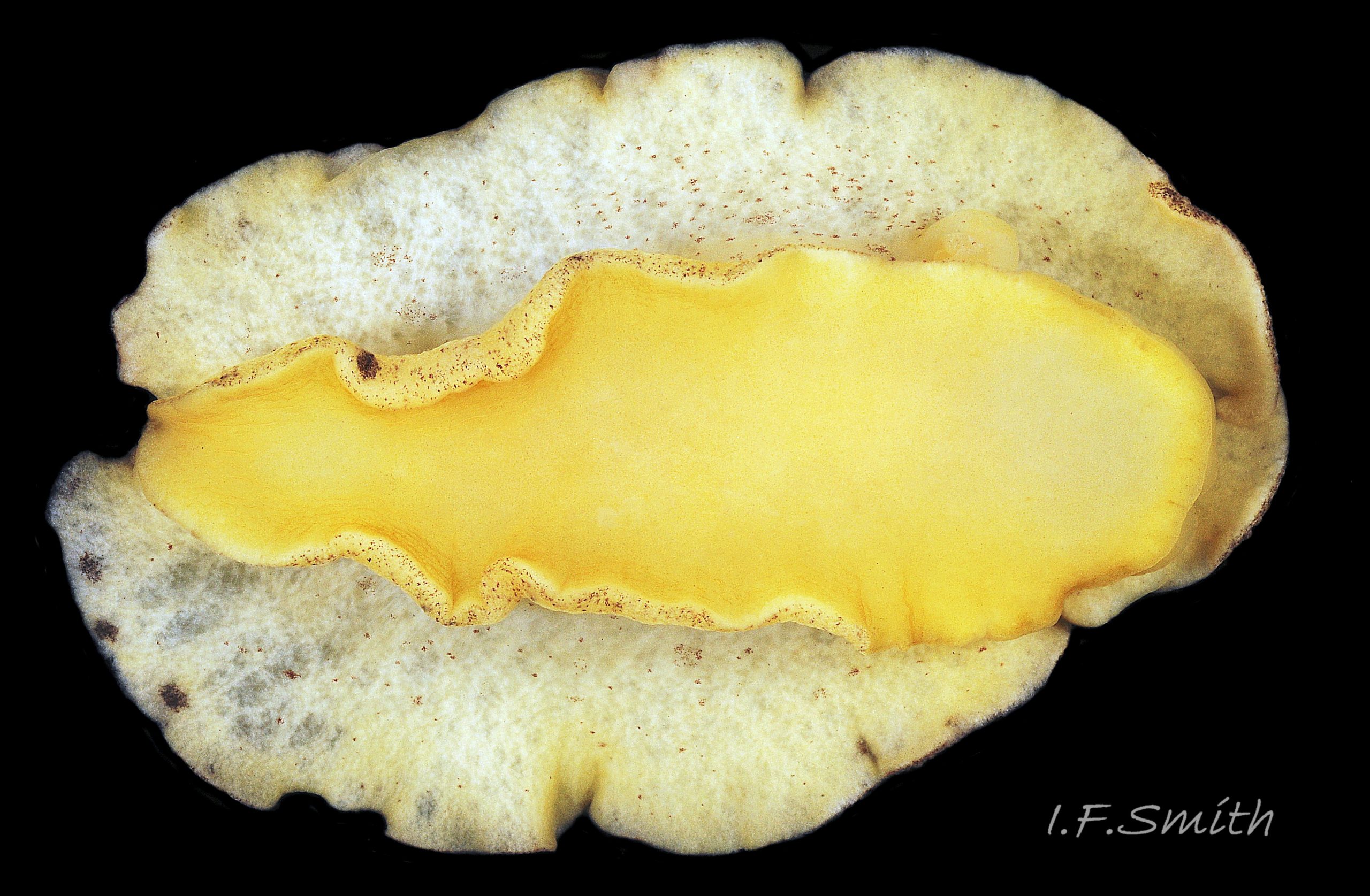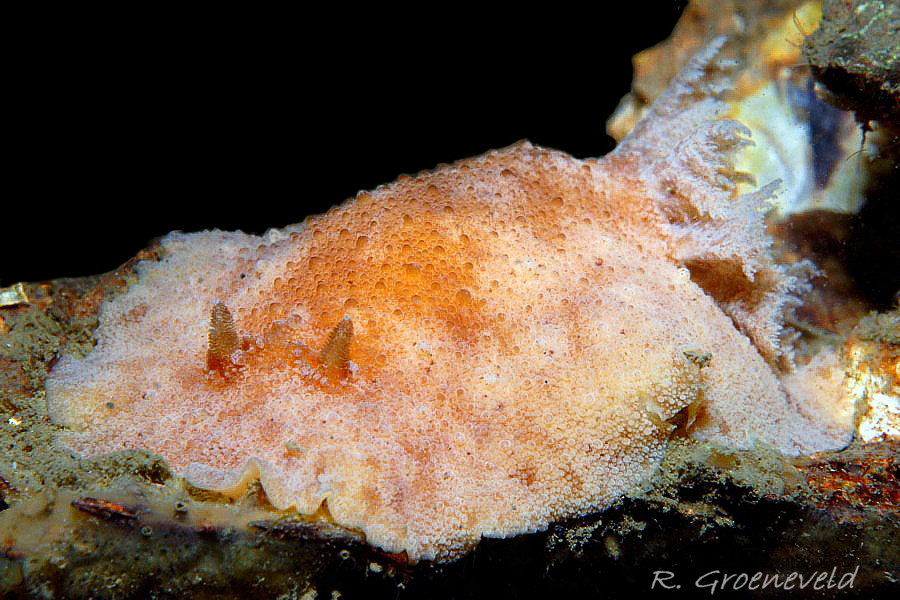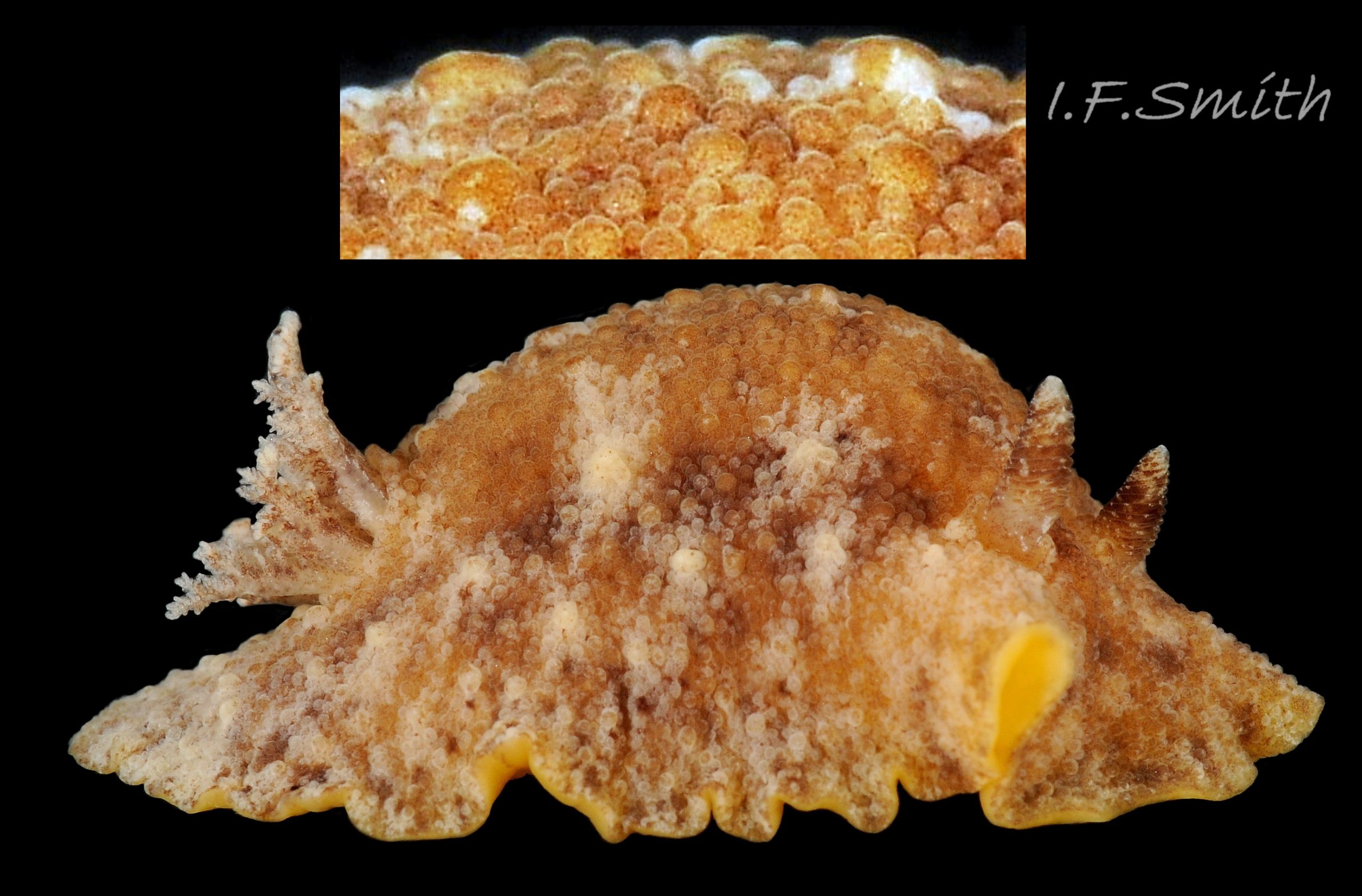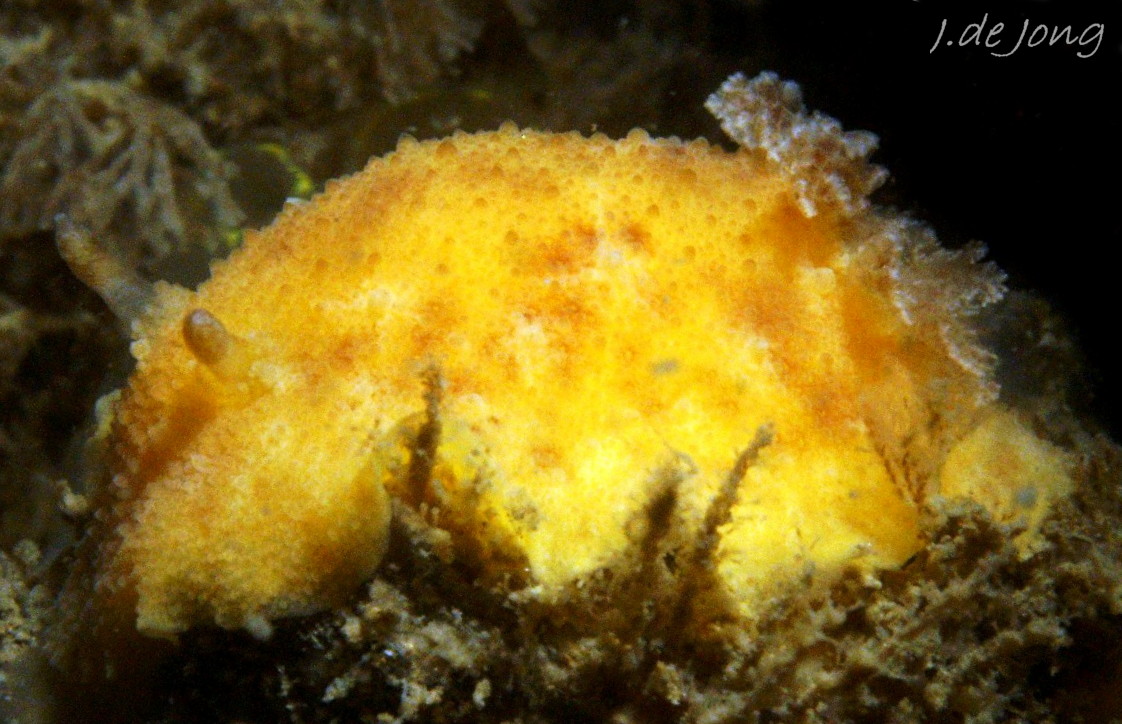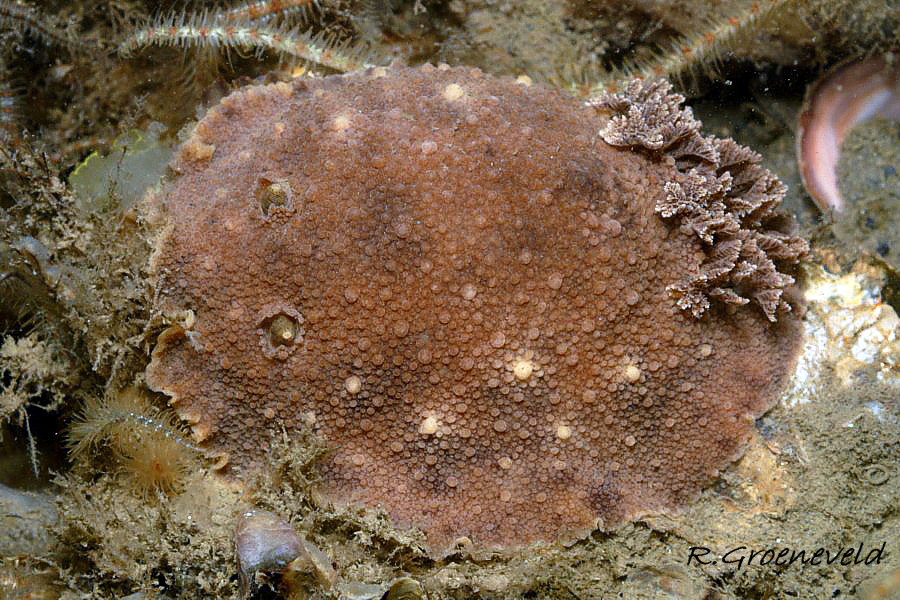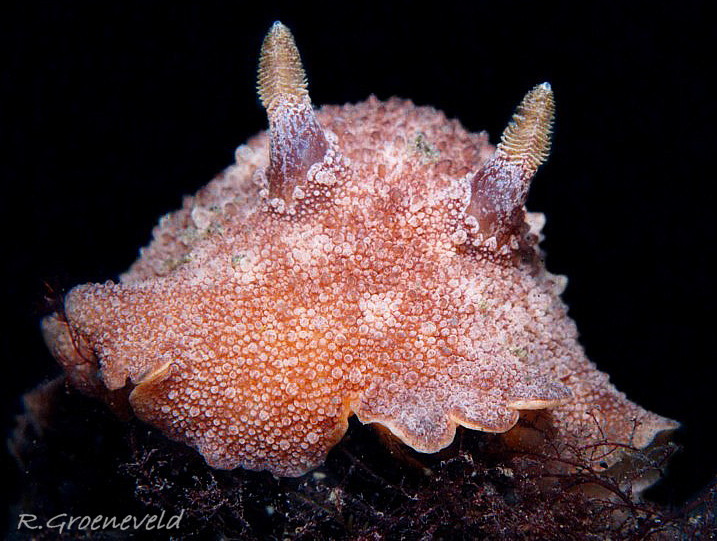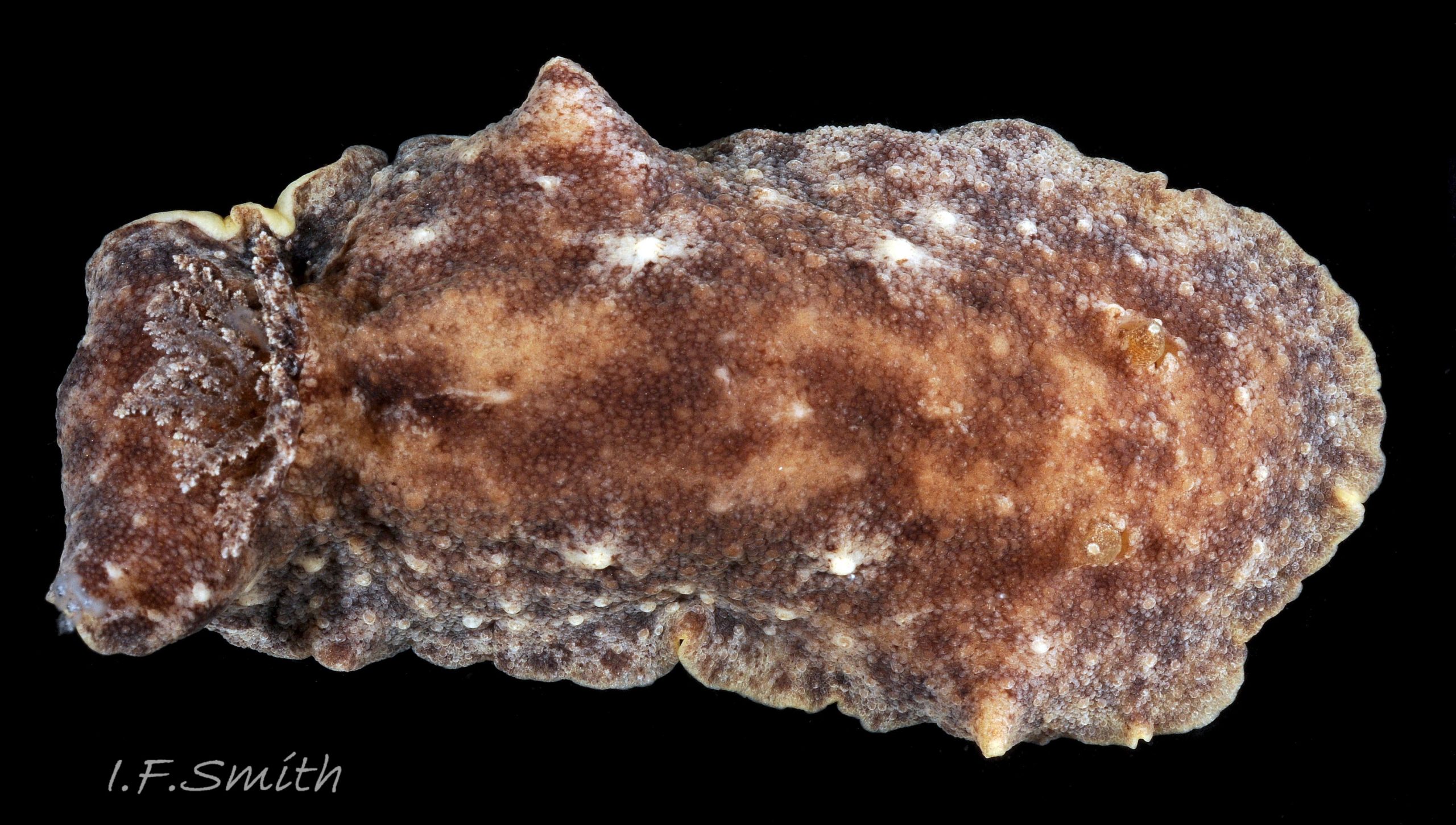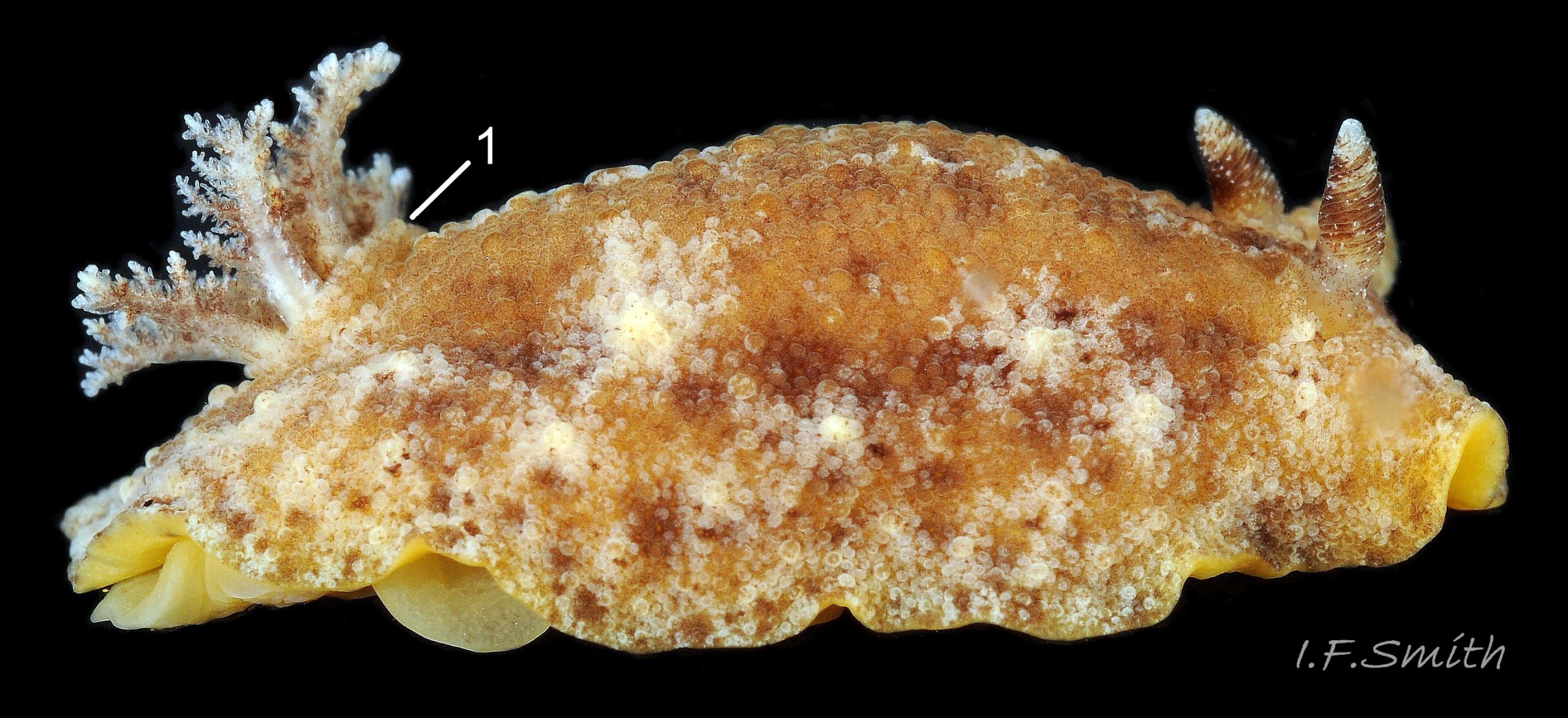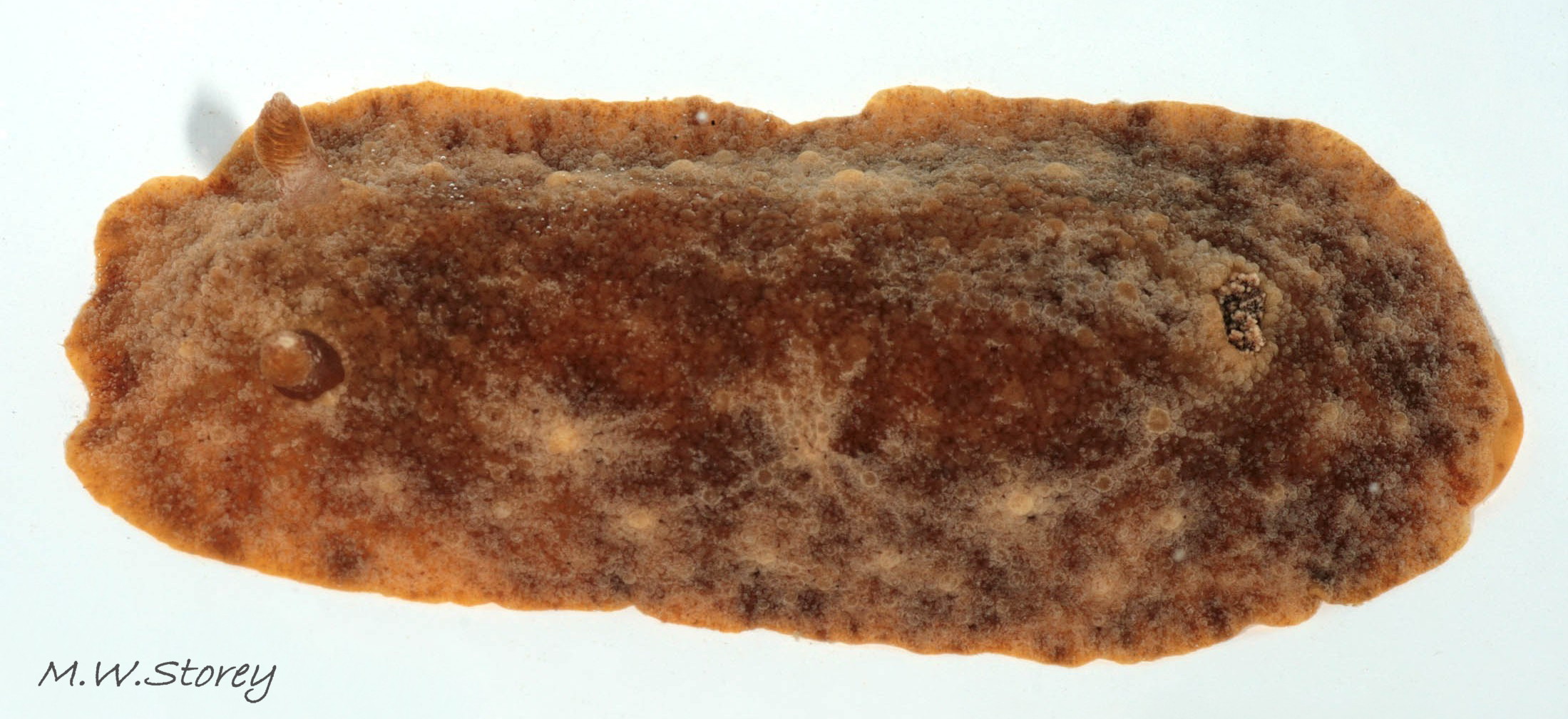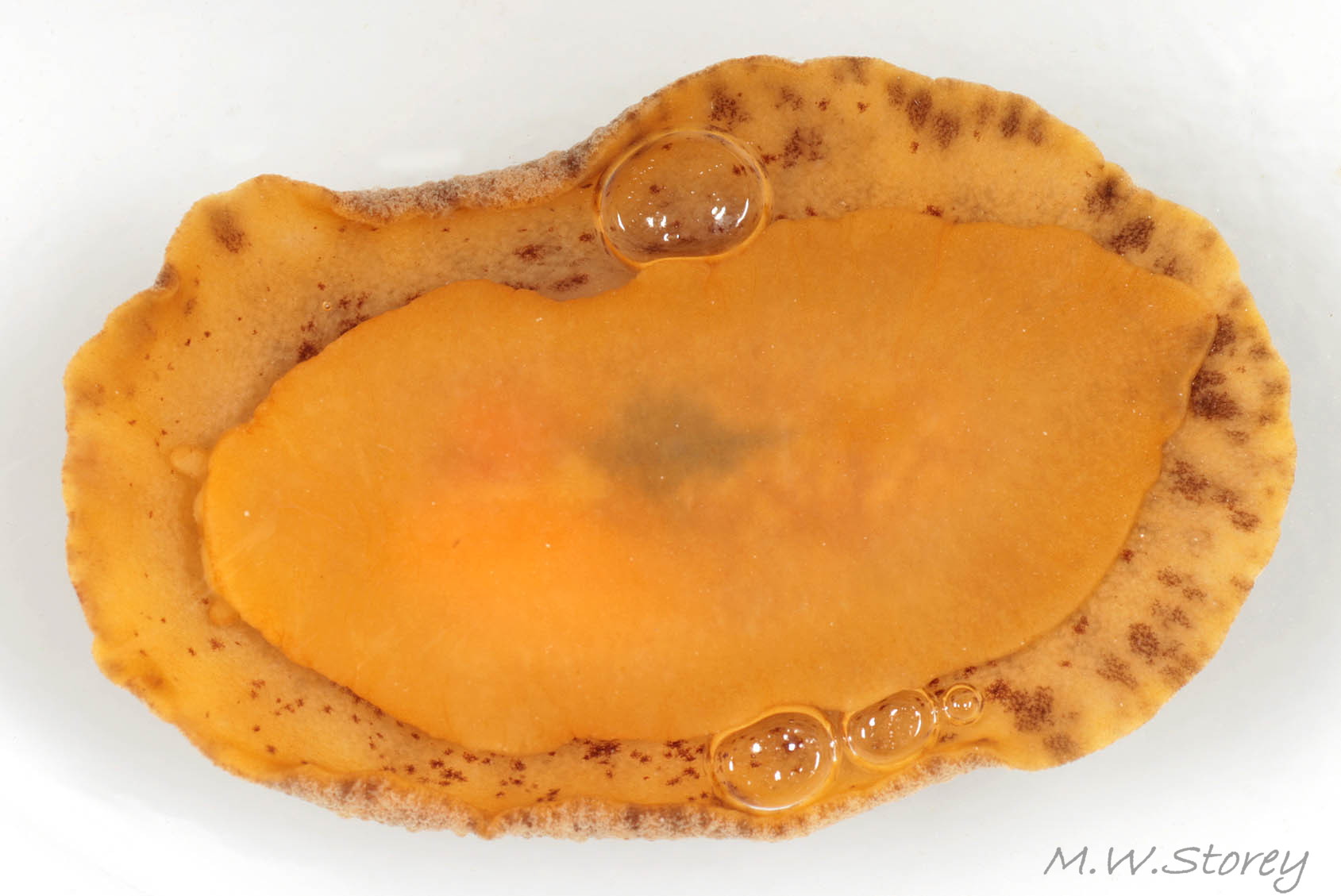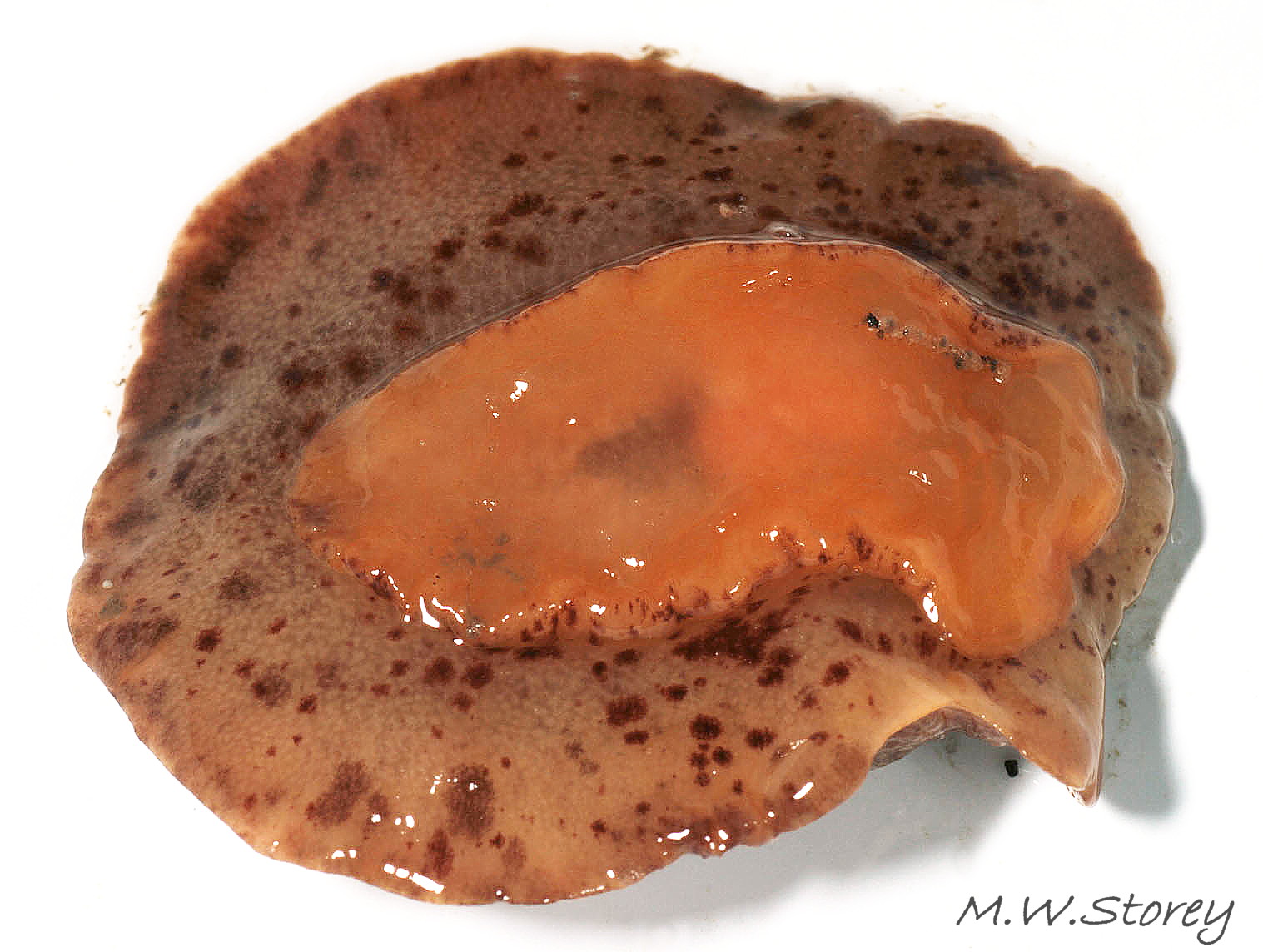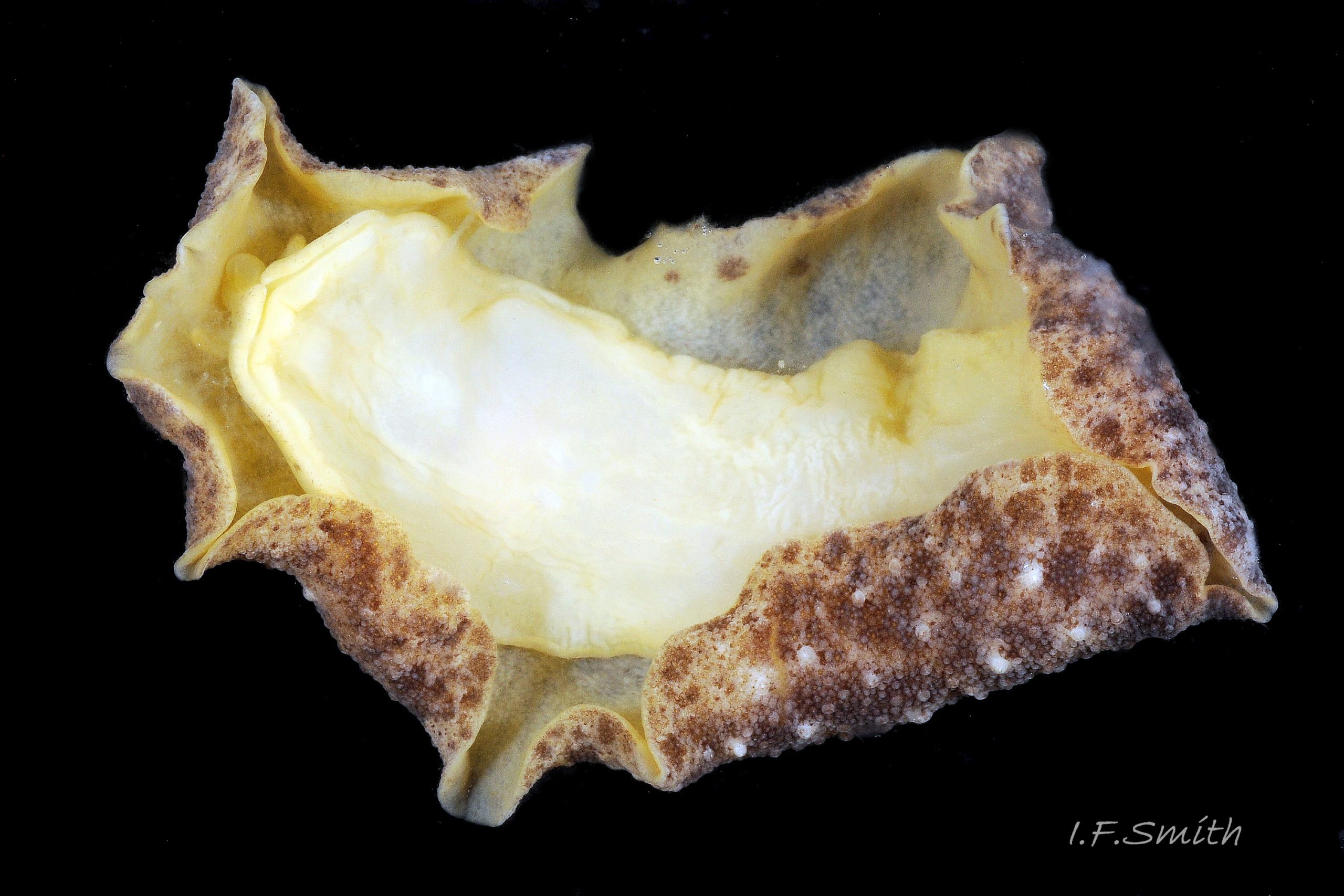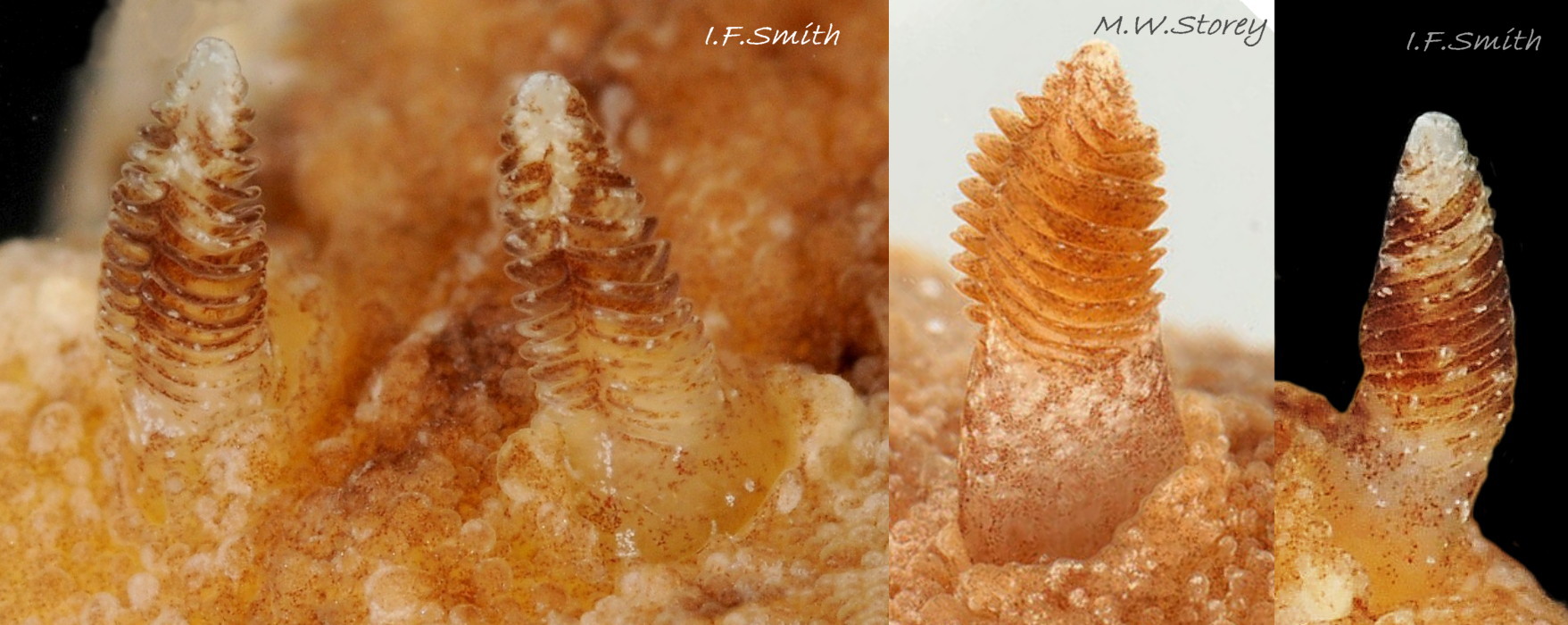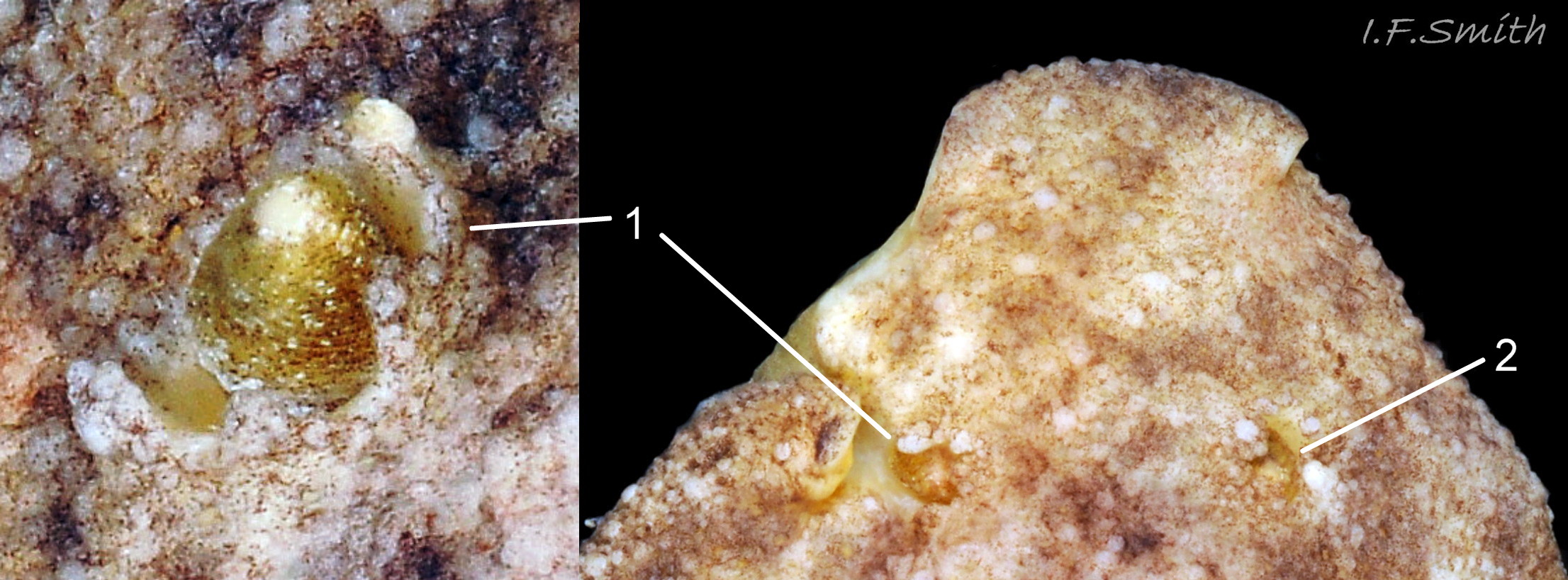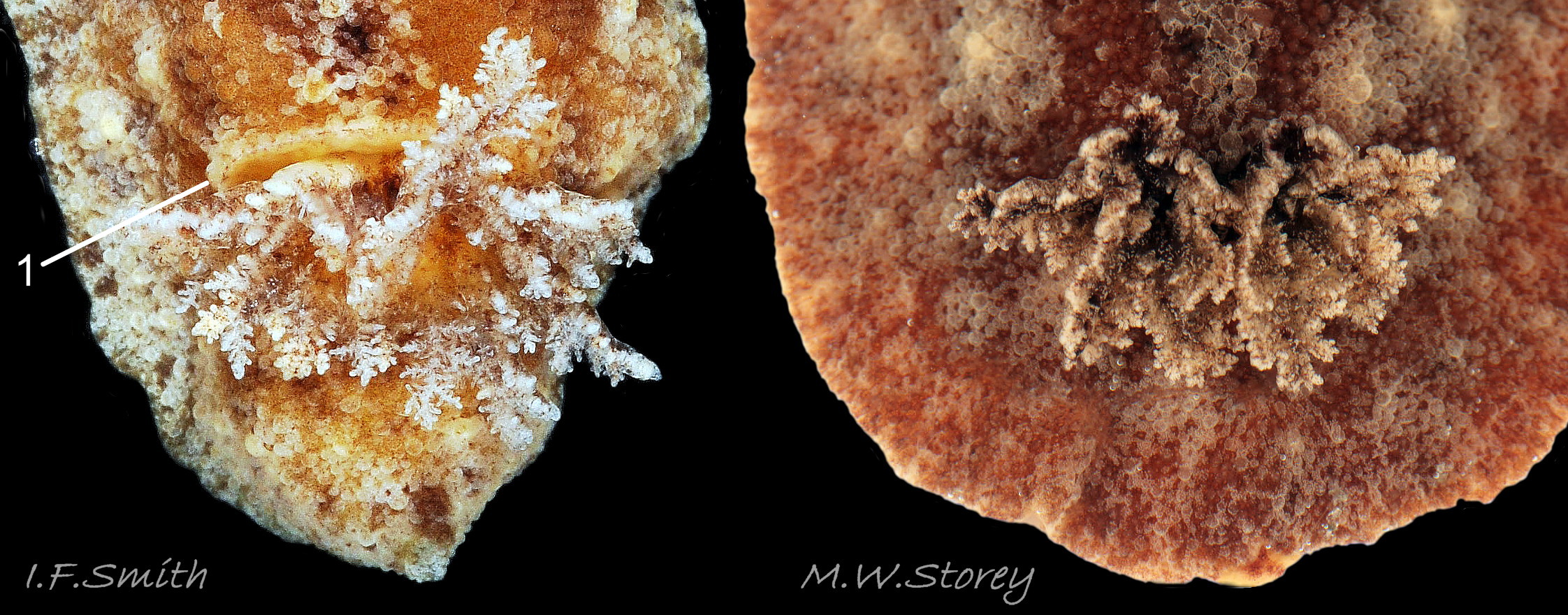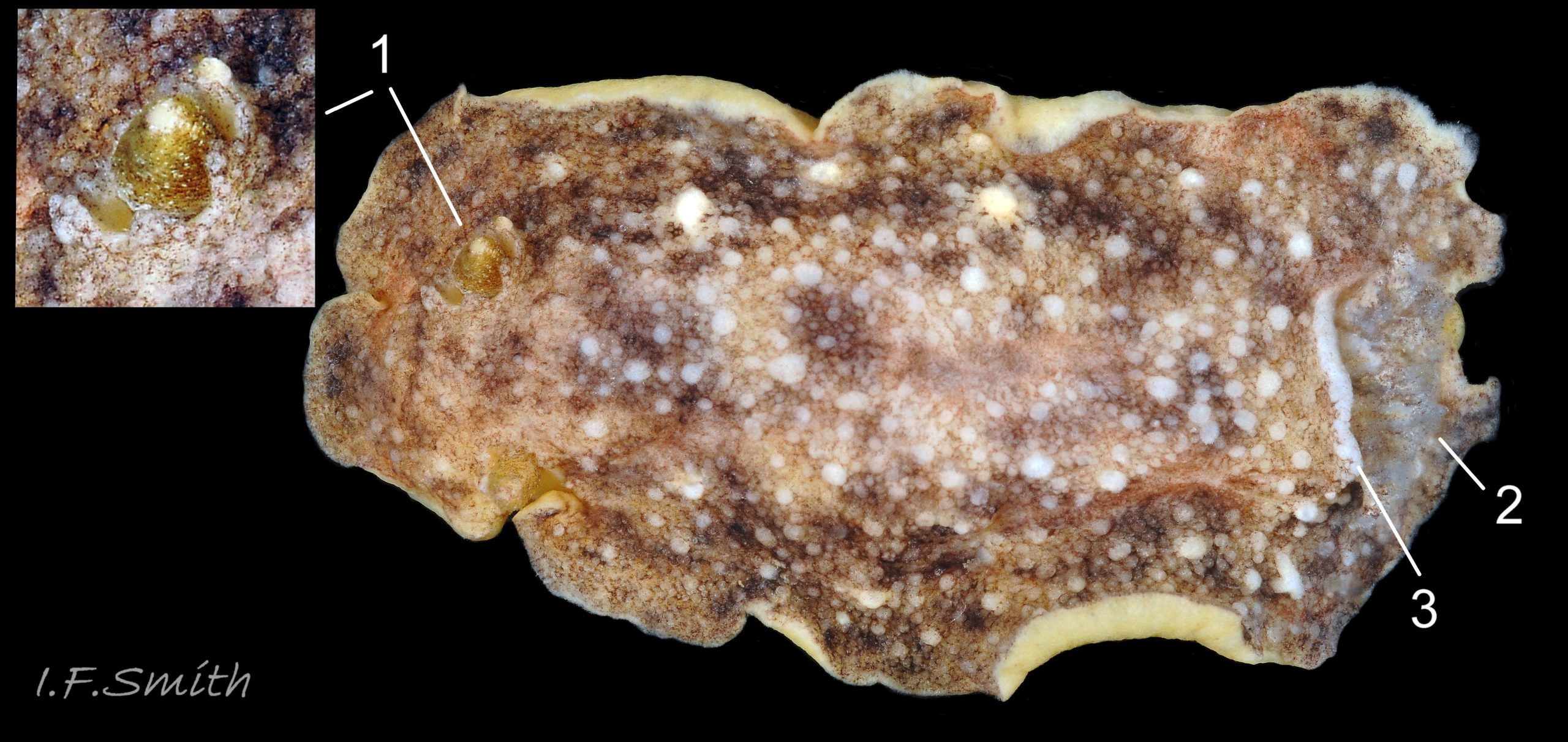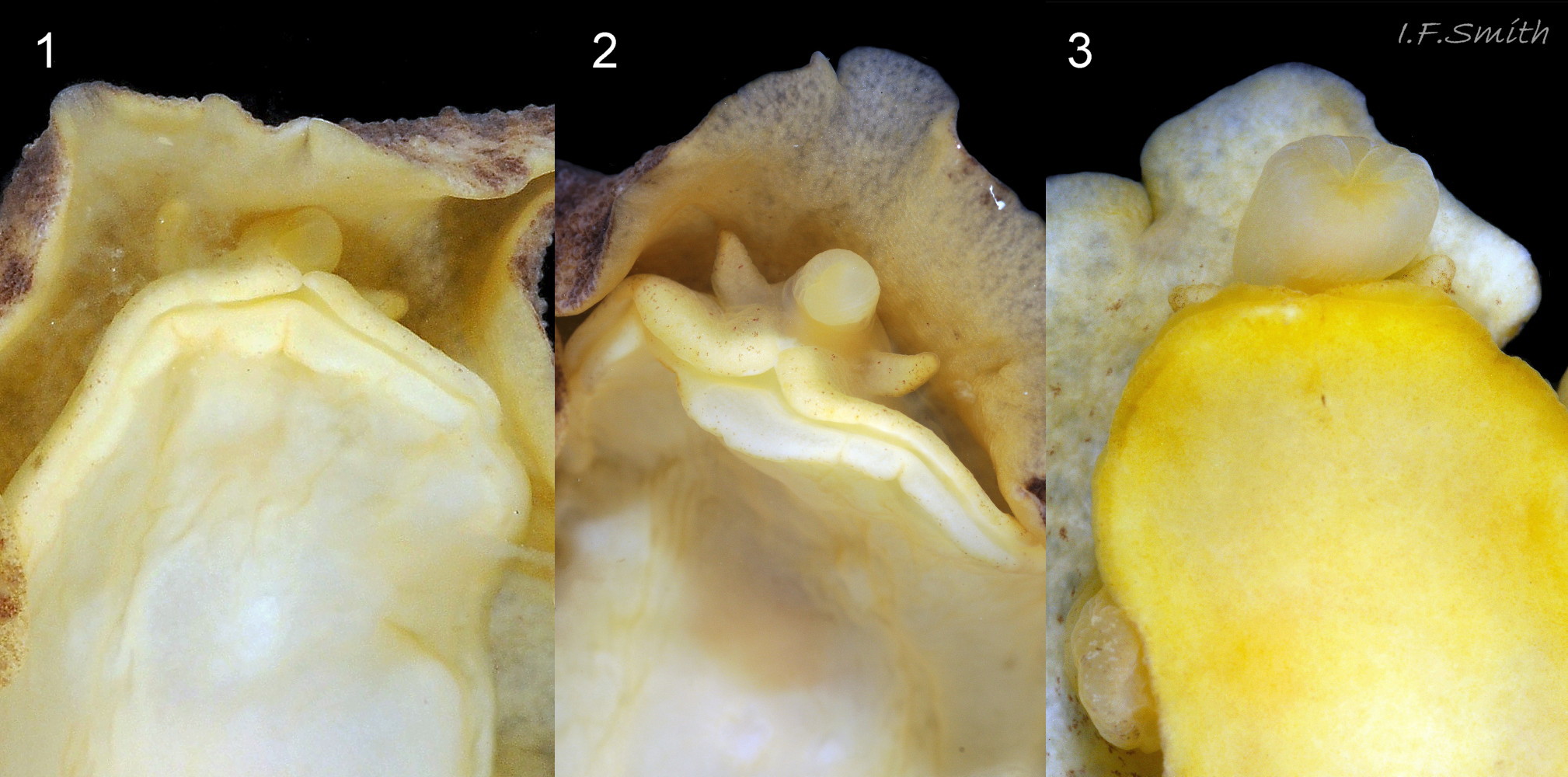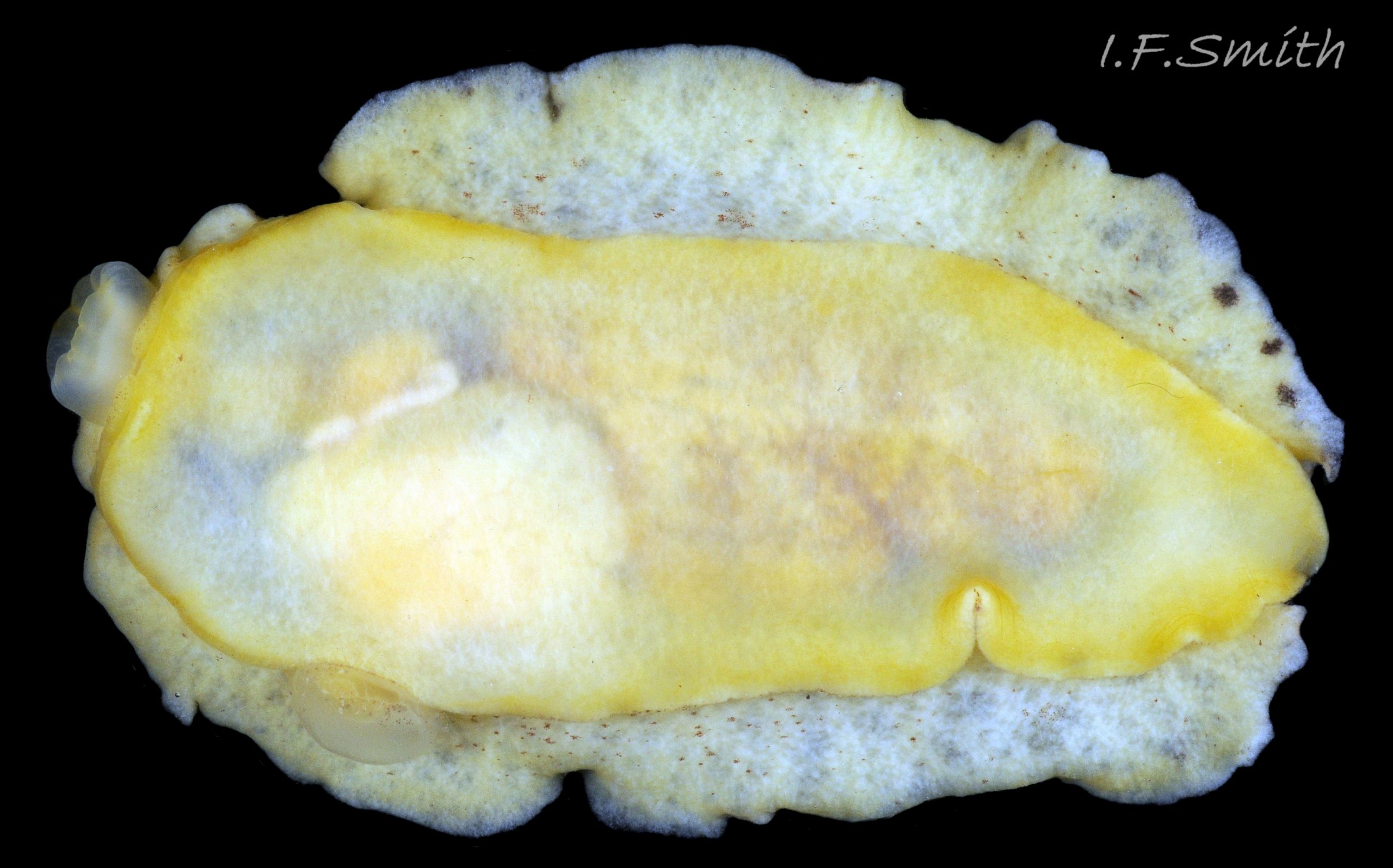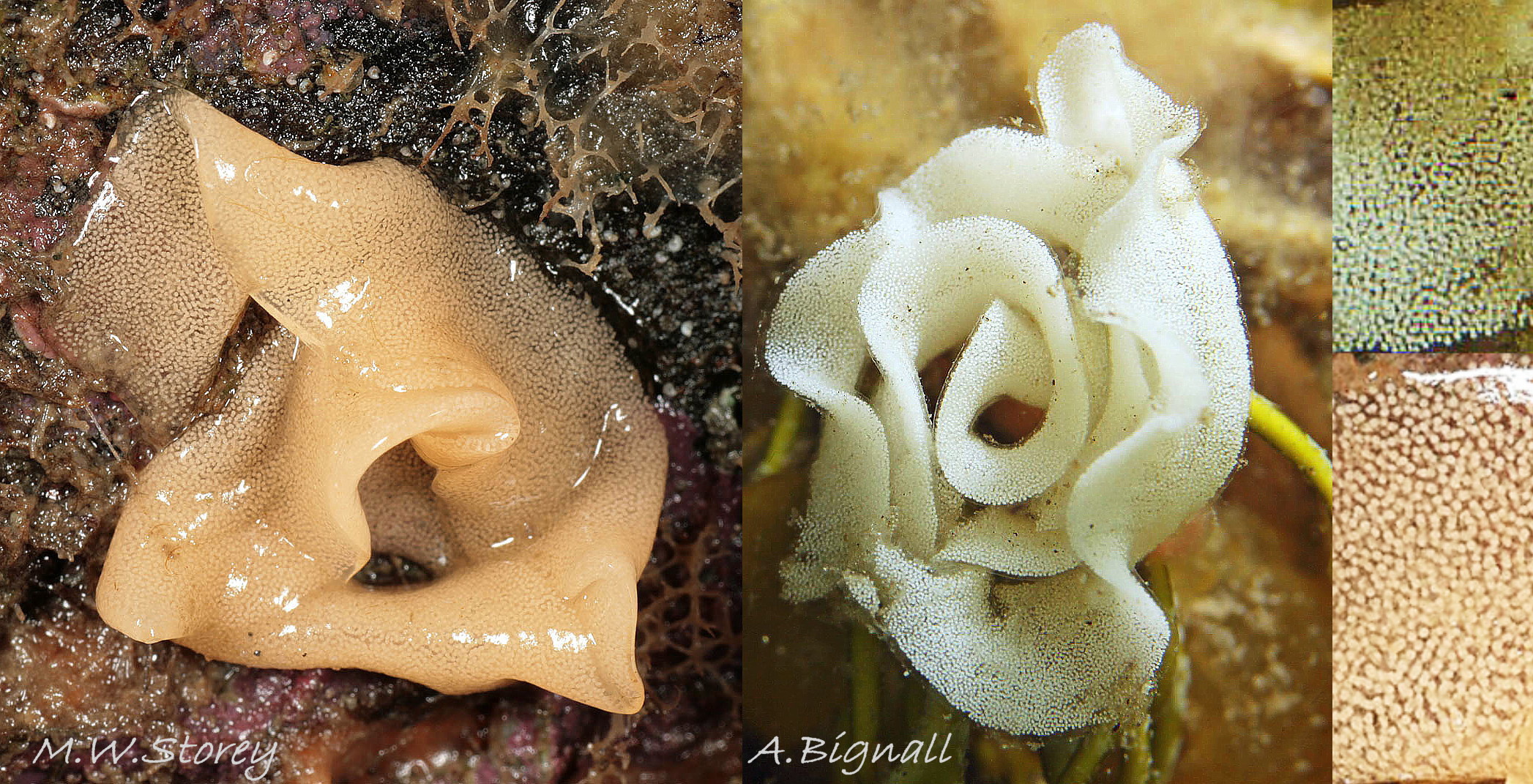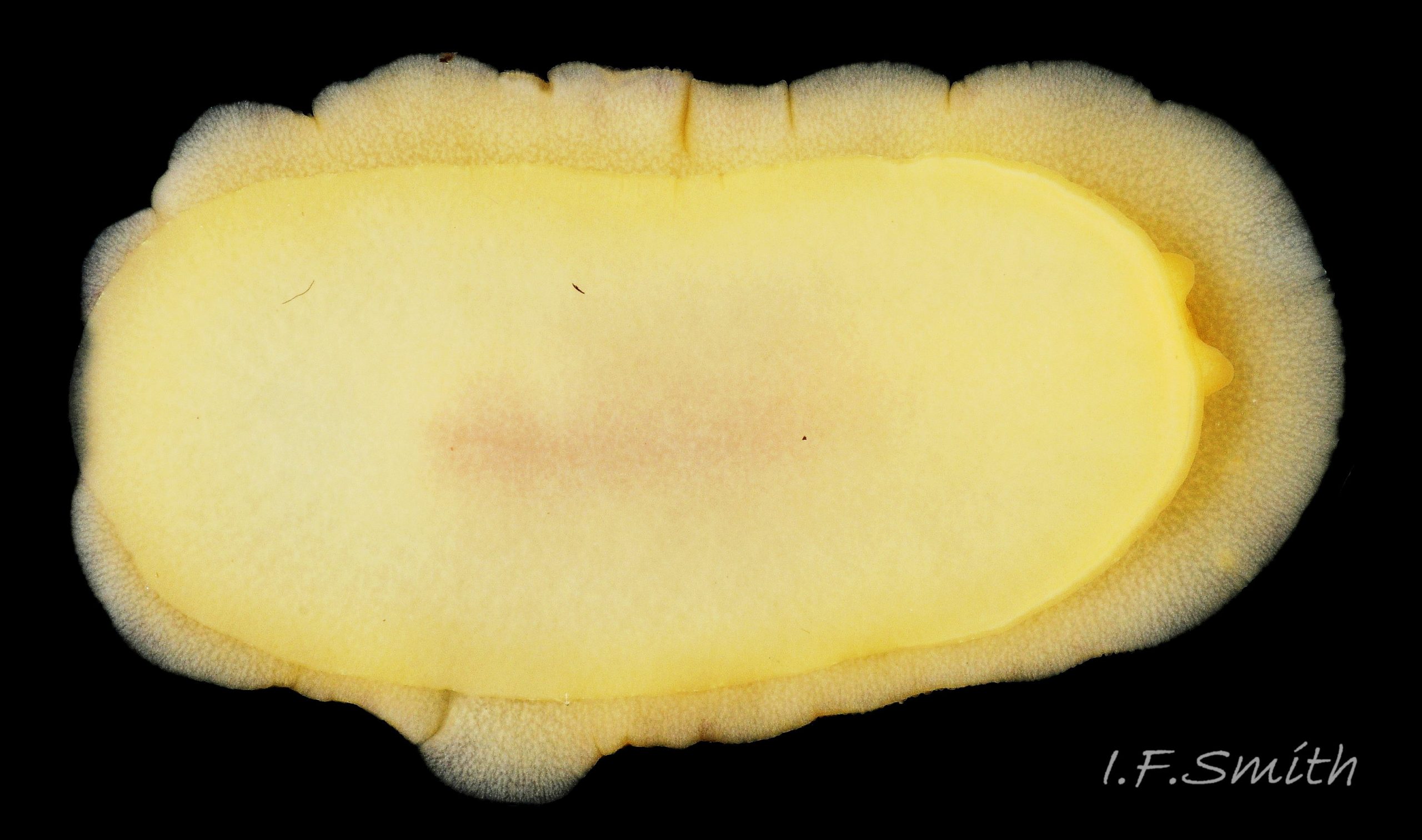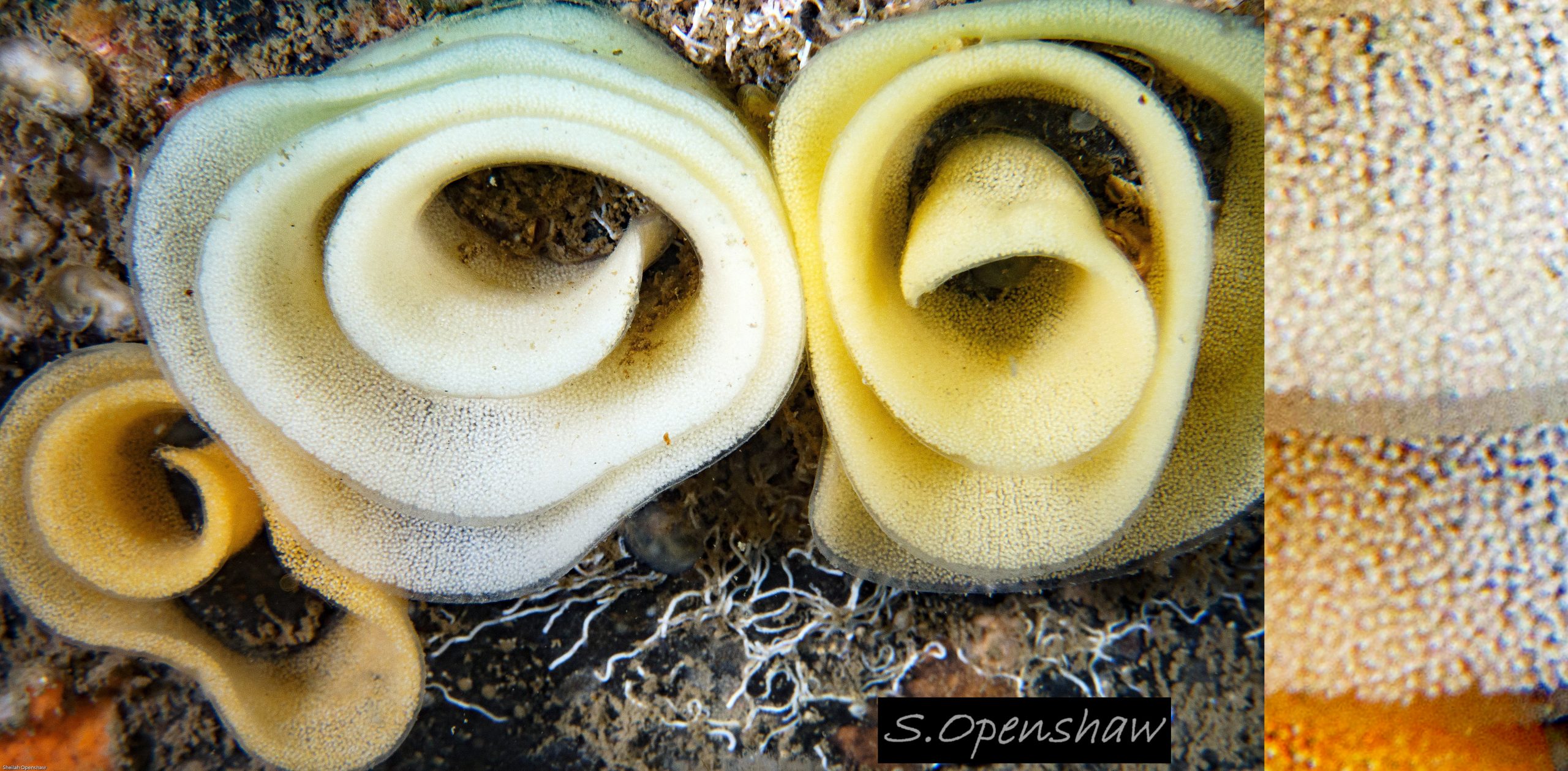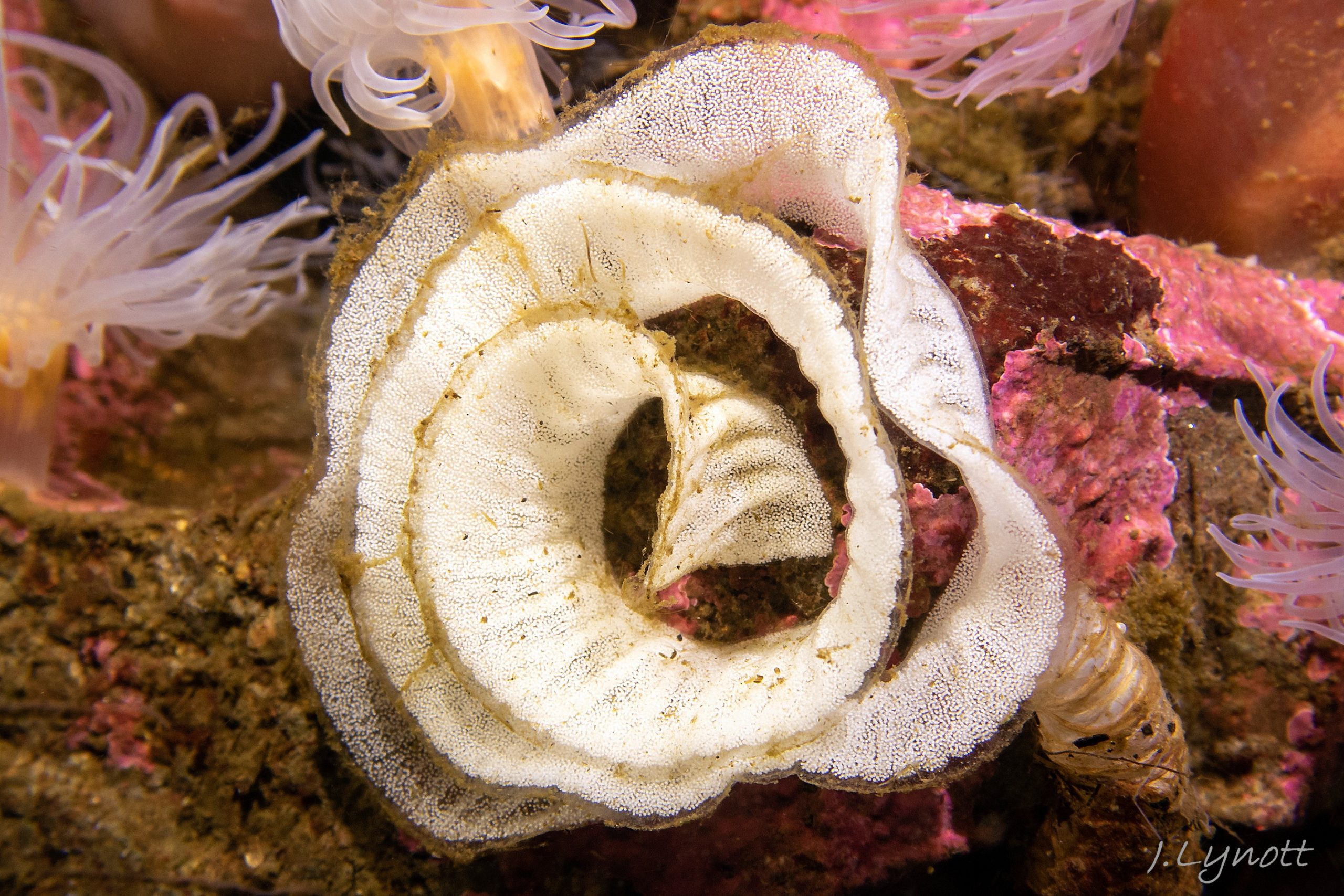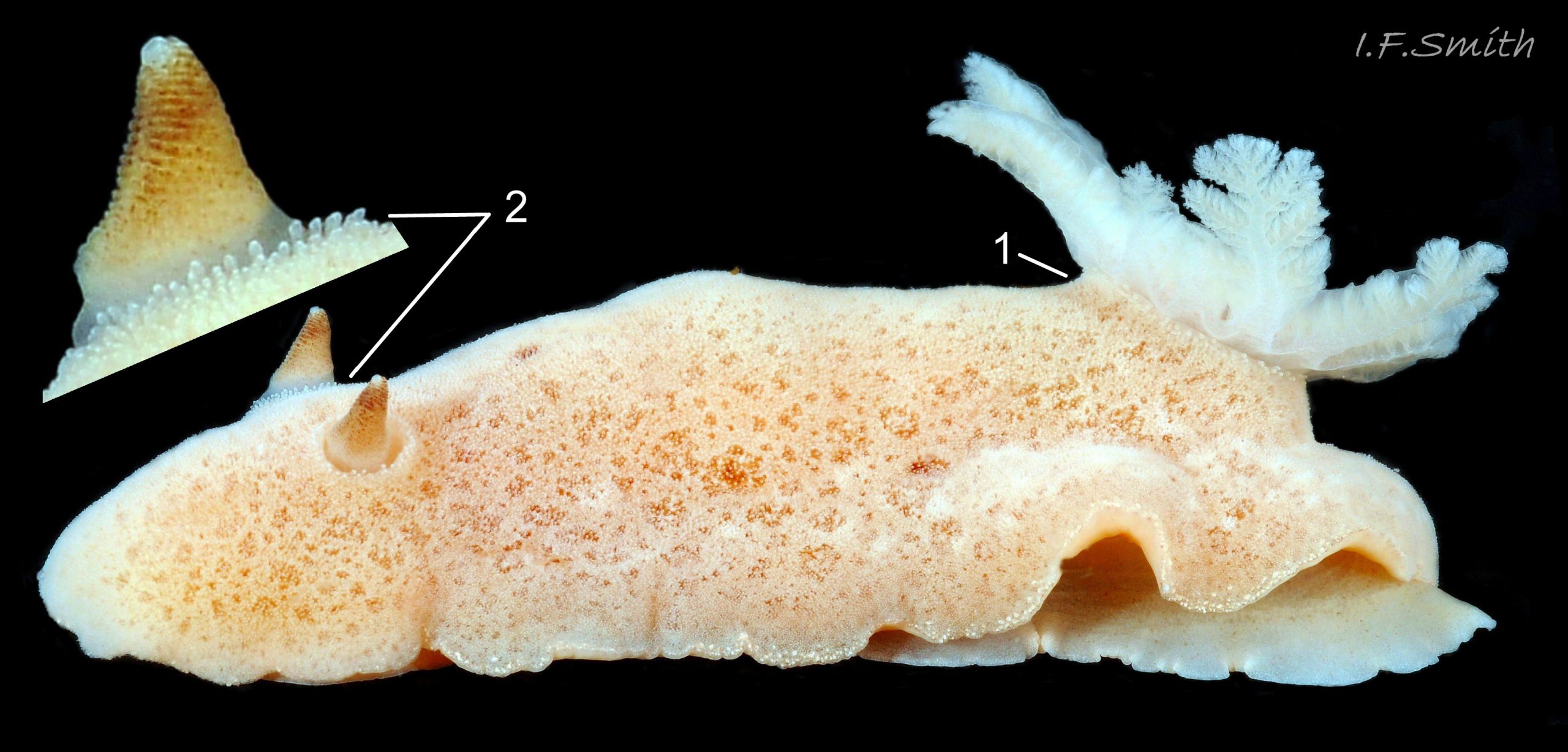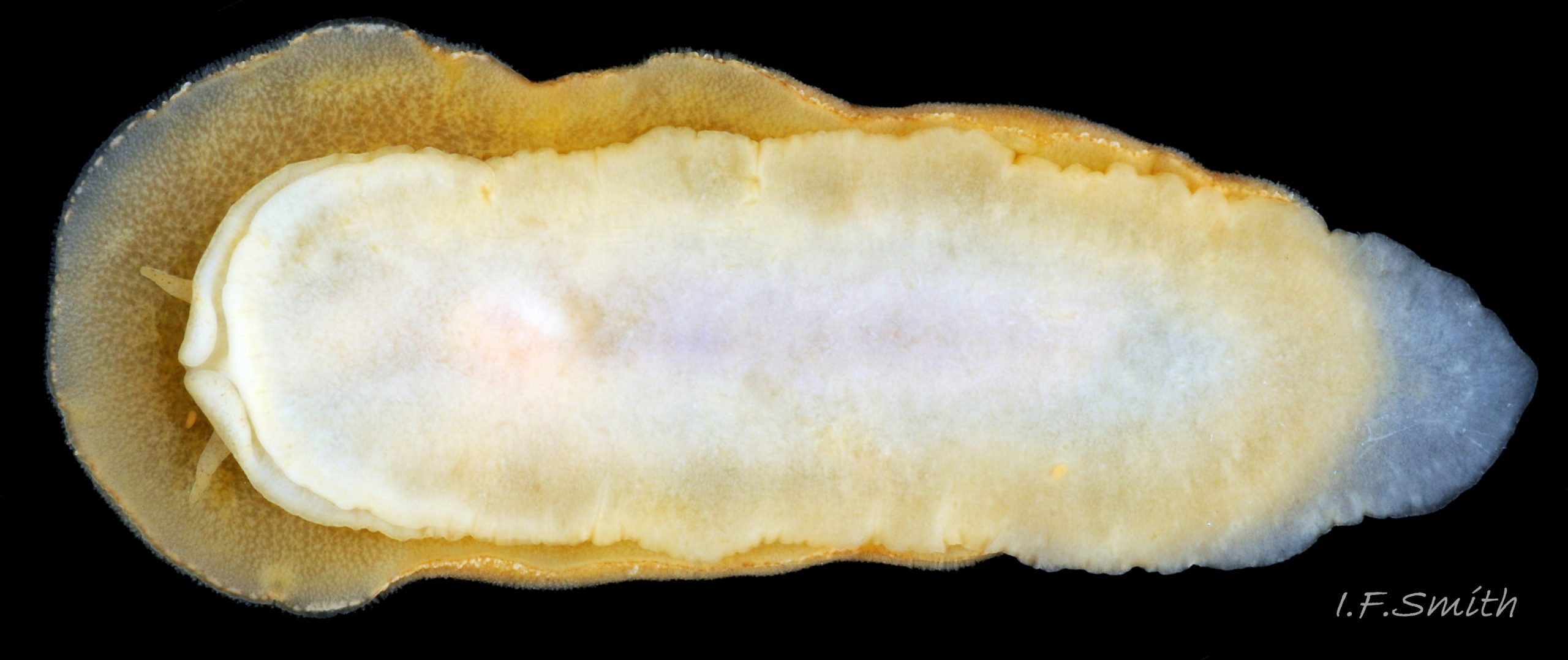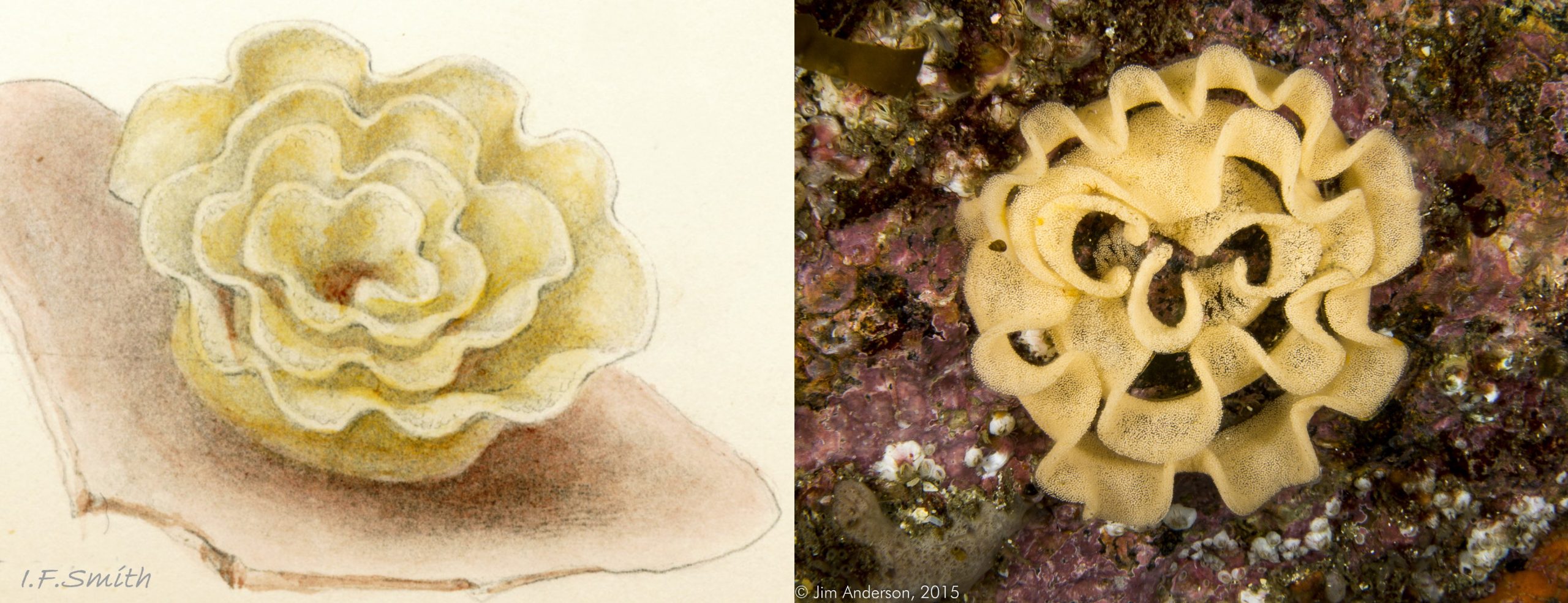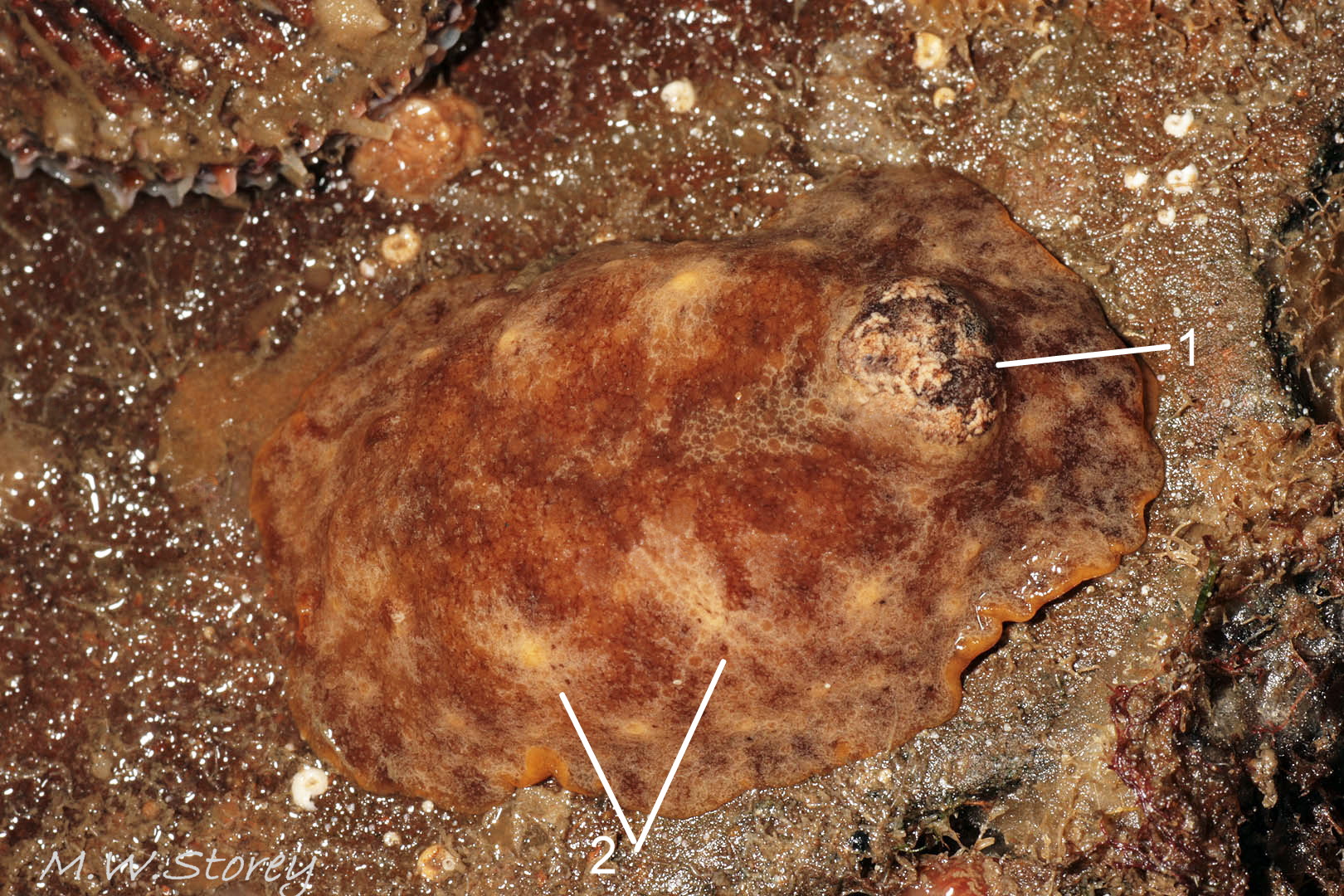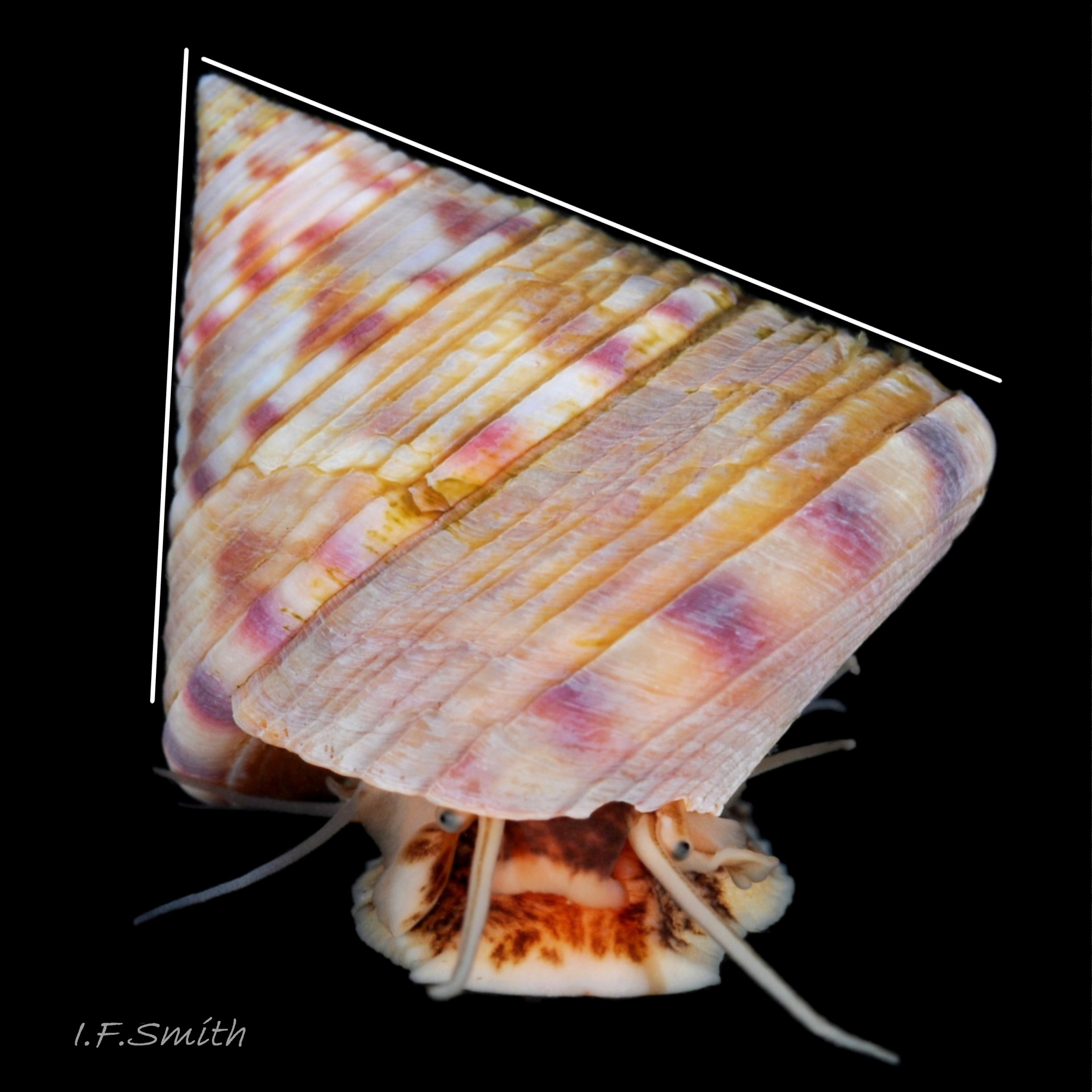Click image to enlarge with full caption. Main text below slider.
Geitodoris planata (Alder & Hancock, 1846)
Authors: Ian Smith (text) and Malcolm Storey (shore work and images).
Synonyms: Doris planata Alder & Hancock, 1846; Discodoris planata (Alder & Hancock, 1846);
Current taxonomy: World Register of Marine Species www.marinespecies.org/aphia.php?p=taxdetails&id=139580
Vernacular name: Millennium wratslak (Dutch)
GLOSSARY BELOW
Description
The body grows up to 65 mm long or, exceptionally, up to 120 mm in the Netherlands (van Bragt, 2004). The ample mantle covers the whole body and extends well beyond the foot 01 Geitodoris planata . It often assumes a low profile similar to that of a planarian worm. The wide mantle skirt is often almost horizontal 02 Geitodoris planata , even when the body is humped up 03 Geitodoris planata . The mantle is covered with tightly packed, rounded, spiculose tubercles which give it a hard and crisp feel. It has various shades of, usually dull, yellow 04 Geitodoris planata , brown 05 Geitodoris planata , orange-brown, pink-brown 02 Geitodoris planata or purple-brown 06 Geitodoris planata & 07 Geitodoris planata . Up to about sixteen papillate, whitish, acid glands 07 Geitodoris planata are usually arranged subdorsally along the flanks 08 Geitodoris planata and are often surrounded by a pale stellate patch 09 Geitodoris planata . The underside of the mantle characteristically has distinct, dark marks of reddish brown 10 Geitodoris planata or purplish brown 11 Geitodoris planata , but sometimes there are few 12 Geitodoris planata or no marks .
The rhinophores have a smooth, stout, translucent basal half speckled 13 Geitodoris planata or blotched 06 Geitodoris planata with purplish brown. The upper half has about twelve or thirteen yellowish lamellae with brown markings 13 Geitodoris planata . They can retract completely into pits with irregular marginal flaps which can fold over and conceal them 14 Geitodoris planata .
The tripinnate gills 15 Geitodoris planata are whitish with brown markings. Each has a stout main stem. They are often arranged into a left and a right group 16 Geitodoris planata . They can retract completely into the branchial pocket 09 Geitodoris planata which has peripheral flap-like valves 16 Geitodoris planata & 17 Geitodoris planata which can close over them.
The head has well developed linear oral tentacles flanking the mouth parts which expand greatly for feeding 18 Geitodoris planata .
The foot has a rounded, bilaminate anterior 18 Geitodoris planata ; the upper lamina is cut centrally and can extend forward of the lower lamina. The sole and dorsal surface of the foot vary from yellowish white 12 Geitodoris planata to dark orange 11 Geitodoris planata . The dorsal surface of the foot often also has dark marks 01 Geitodoris planata & 11 Geitodoris planata similar to those on the underside of mantle. It may occasionally protrude very slightly when in motion 09 Geitodoris planata , but is otherwise of much less extent than the mantle. When horizontally lit with a strong flash, internal viscera may be visible through the sole 19 Geitodoris planata .
Key identification features
Geitodoris planata
1) Up to 65 mm long (exceptionally 120 mm in Netherlands).
2) Dull yellow or shade of brown, generally less colourful and variegated than Doris pseudoargus.
3) Rounded spiculose tubercles 03 Geitodoris planata , smaller than largest ones of D. pseudoargus, much bigger than digital caryophyllidia on Jorunna tomentosa. Animal feels hard and crisp.
4) Dark marks on underside of mantle 11 Geitodoris planata . (Occasionally absent ).
5) Up to 12 whitish papillate acid glands on sides of mantle, often in stellate pale patch 08 Geitodoris planata .
6) Foot much smaller than mantle 01 Geitodoris planata .
7) Head has well developed linear oral tentacles 18 Geitodoris planata .
8) Gills whitish with brown pigment marks; often formed into a left and a right group 16 Geitodoris planata .
9) Spawn a broad, undulate ribbon laid in a spiral attached to substrate by one edge. With age, colour may change white to yellow and spiral becomes looser. Ova arranged in ribbon randomly; not in discernible lines 20 Geitodoris planata .
Similar species
Doris pseudoargus 21 Geitodoris planata COMPARE Doris pseudoargus
1) Up to 120 mm long, half grown ones similar size to G. planata.
2) Mantle usually yellow or buff-orange, often with large blotches of bright colours.
3) Variously sized, rounded, spiculose tubercles give stiff unyielding feel to mantle, but G. planata even stiffer.
4) Underside of mantle lacks dark markings (may have slight staining at edge) 22 Geitodoris planata COMPARE Doris pseudoargus .
5) No whitish, papillate, acid glands on sides of mantle.
6) Foot not much smaller than mantle.
7) Head small with vestigial oral tentacles.
8) Translucent gills often tinted purple or lilac.
9) Spawn a broad, undulate ribbon laid in a spiral attached to substrate by one edge. With age, colour may change white to yellow and spiral becomes looser. Ova arranged in transverse lines 23 Geitodoris planata COMPARE Doris pseudoargus & 24 Geitodoris planata COMPARE Doris pseudoargus .
Jorunna tomentosa 25 Geitodoris planata COMPARE Jorunna tomentosa
1) Up to 60 mm long, similar size to G. planata.
2) Mantle sandy, buff, or whitish; any other marks few, small and dark.
3) Very small digital caryophyllidia cover mantle densely; velvety appearance, soft feel.
4) Underside of mantle lacks dark markings 26 Geitodoris planata COMPARE Jorunna tomentosa .
5) No whitish, papillate, acid glands on sides of mantle.
6) Foot not much smaller than mantle. Extends well behind mantle when in motion.
7) Head has well developed linear oral tentacles
8) Whitish or yellow gills with no opaque pigment marks encircle brown anus. Base of extended gills surrounded by raised collar.
9) Spawn a broad, strongly crimped ribbon laid in a spiral attached to substrate by one edge. Ova arranged randomly 27 Geitodoris planata COMPARE Jorunna tomentosa .
Habits and ecology
G. planata occurs at LWS on rocky shores and on oyster beds and sublittorally to 45 m. It is well camouflaged on stone by its dull colours and lack of shadow from its flat profile 28 Geitodoris planata & 29 Geitodoris planata . It feeds on sponges such as Hemimycale columella, Mycale rotalis and Mycale micracanthoxea. It exudes defensive acid from whitish papillate glands on the flanks of the mantle. When disturbed, it tends to remain flattish while it contorts, rather than contracting tightly like Doris pseudoargus. Like other nudibranchs, it is a simultaneous hermaphrodite. In north-west Europe it mates and spawns from late spring to late autumn 29 Geitodoris planata . The spawn mass is a broad, undulating ribbon laid in a spiral attached to the substrate by one edge. It is white or yellow, probably changing with age. The ova are arranged randomly in the ribbon; not in discernible transverse lines 20 Geitodoris planata .
Distribution and status
The range of G. planata has expanded this century and now includes Norway, Britain, Ireland, Netherlands, Brittany, Spain and New England (USA), GBIF map www.gbif.org/species/2292467 . A population explosion, including very large specimens, around the year 2000 was observed in the Oosterschelde, Netherlands (van Bragt, 2001, 2004 & 2013). Its timing led to its Dutch name, “Millennium wratslak”. By 2005 numbers had declined, but it is still present in the Oosterschelde.
Finds have also increased in Britain and it is found widely on rocky coasts, but it may still be scarce in south-east England, UK map NBN species.nbnatlas.org/species/NBNSYS0000175442
Acknowledgements
For use of images I thank Jim Anderson, Anne Bignall, Rokus Groeneveld www.diverosa.com , John de Jong www.jojodive.nl , James Lynott, Sheilah Openshaw, Allan Rowat, Malcolm Storey www.bioimages.org.uk and Stefan Verheyen.
References and links
Alder J. & Hancock A. 1846. Notices of some new and rare British species of naked Mollusca. Annals and Magazine of Natural History 18: 289-294, pl. 4
www.biodiversitylibrary.org/page/2319713#page/312/mode/1up
Alder, J. & Hancock, A. 1845-1855. A monograph of the British nudibranchiate mollusca. London, Ray Society. Family 1 Plate 8 www.biodiversitylibrary.org/item/131598#page/118/mode/1up
Rudman, W.B. Geitodoris planata in The Sea Slug Forum www.seaslugforum.net/find/geitplan (accessed December 2022)
Thompson, T.E. & Brown, G.H. 1984. Biology of opisthobranch molluscs 2. London, Ray Society.
van Bragt, P.H. 2001. Geitodoris planata – population explosion in Holland, on the Sea slug Forum www.seaslugforum.net/message/5125
van Bragt, P.H., 2004. The sea slugs, Sacoglossa and Nudibranchia
(Gastropoda, Opisthobranchia), of the Netherlands. Vita Malacologica, 2: 3-32, plates 1- 10.
van Bragt, P.H., 2013, Millennium-wratslak, Geitodoris planata (Alder & Hancock, 1846), Soorten, Stichting Anemoon, Netherlands. Accessed 4 November 2022
www.anemoon.org/flora-en-fauna/soorteninformatie/soorten/…
Glossary
caryophyllidia = digital tubercles with terminal knob surrounded by coronet of spikes, like a clove (spice), on some dorid sea slugs.
cephalic = (adj.) of or on the head.
dorid = a sea slug in the infraorder Doridoidei; usually with gills and rhinophores on the dorsum; often shaped like half a lemon or grape.
lamellae = small plates on rhinophores, or leaflets of gill.(sing. lamella)
mantle = (of sea slugs) sheet of tissue forming part or all of notum.
notum = dorsal body surface.
papilla = (pl. papillae) small cone-shaped protrusion of flesh.
papillate = shaped like a papilla or bearing papillae.
plankton = animals and plants that drift in pelagic zone (main body of water).
rhinophores (pl.) = chemo-receptor tentacles on top of head of nudibranch.
tripinnate = (of gill plume) threefold branching; “boughs, branches, twigs” in one plane like a feather.
spicule (in dorid seaslugs) = small, slender, sharp-pointed feature mainly composed of calcite (CaCO3) and brucite (Mg(OH)2) .
stellate = arranged in a radiating pattern like that of a star.
veliger = shelled larva of marine gastropod or bivalve mollusc which swims by beating cilia of a velum (bilobed flap).
